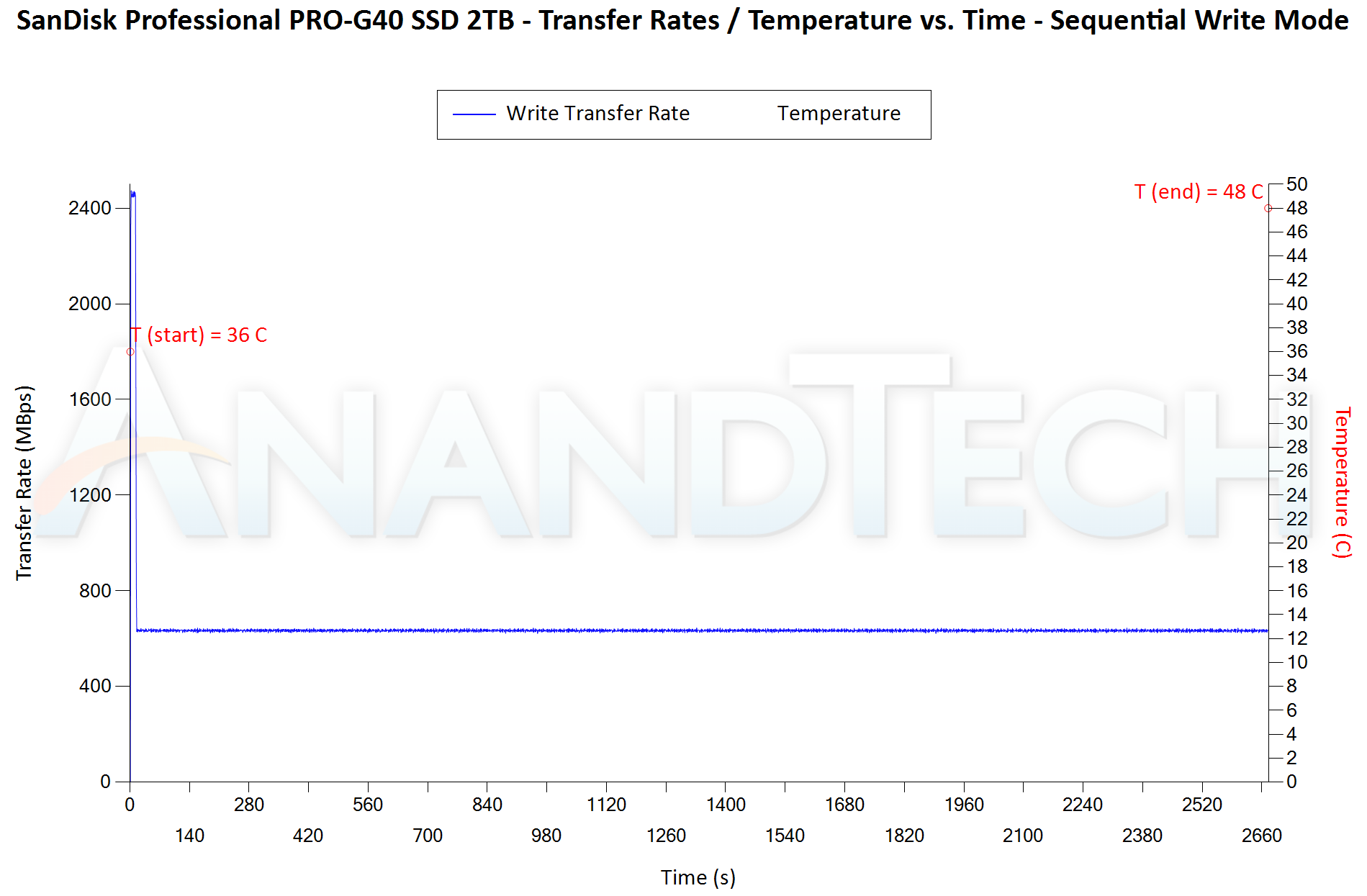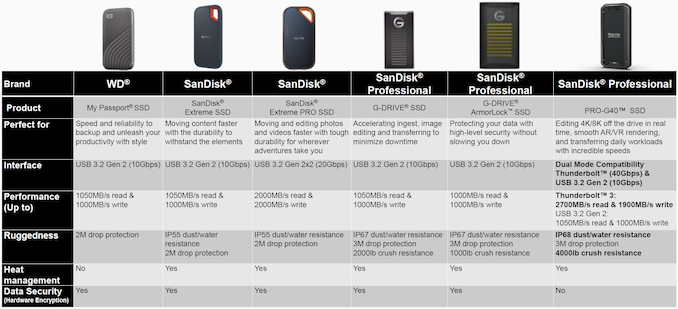SanDisk Professional PRO-G40 Thunderbolt / USB Dual-Mode Portable SSD Review
by Ganesh T S on October 6, 2022 8:00 AM ESTMiscellaneous Aspects and Concluding Remarks
The performance of the portable SSDs in various real-world access traces as well as synthetic workloads was brought out in the preceding sections. We also looked at the performance consistency for these cases. Power users may also be interested in performance consistency under worst-case conditions, as well as drive power consumption. The latter is also important when used with battery powered devices such as notebooks and smartphones. Pricing is also an important aspect. We analyze each of these in detail below.
Worst-Case Performance Consistency
Flash-based storage devices tend to slow down in unpredictable ways when subject to a large number of small-sized random writes. Many benchmarks use that scheme to pre-condition devices prior to the actual testing in order to get a worst-case representative number. Fortunately, such workloads are uncommon for direct-attached storage devices, where workloads are largely sequential in nature. Use of SLC caching as well as firmware caps to prevent overheating may cause drop in write speeds when a flash-based DAS device is subject to sustained sequential writes.
Our Sequential Writes Performance Consistency Test configures the device as a raw physical disk (after deleting configured volumes). A fio workload is set up to write sequential data to the raw drive with a block size of 128K and iodepth of 32 to cover 90% of the drive capacity. The internal temperature is recorded at either end of the workload, while the instantaneous write data rate and cumulative total write data amount are recorded at 1-second intervals.
| Sequential Writes to 90% Capacity - Performance Consistency | |
| TOP: | BOTTOM: |
 |
|
 |
|
The PRO-G40 2TB PSSD maintains top write speeds for around 32GB of data before falling off due to the SLC cache cliff. The 'direct-to-TLC' write speeds end up at around 1500 MBps when write caching is enabled in the OS. In the default configuration, the speed drops down to 650 MBps. The end temperature is only 48C in this case, but 52C when the higher speeds are involved. These are not high enough to cause throttling, pointing to the excellent thermal design of the enclosure.
Power Consumption
Bus-powered devices can configure themselves to operate within the power delivery constraints of the host port. While Thunderbolt ports are guaranteed to supply up to 15W for client devices, USB 2.0 ports are guaranteed to deliver only 4.5W (900mA @ 5V). In this context, it is interesting to have a fine-grained look at the power consumption profile of the various external drives. Using the Plugable USBC-TKEY, the bus power consumption of the drives was tracked while processing the CrystalDiskMark workloads (separated by 5s intervals). The graphs below plot the instantaneous bus power consumption against time, while singling out the maximum and minimum power consumption numbers.
| CrystalDiskMark Workloads - Power Consumption | |
| TOP: | BOTTOM: |
 |
|
 |
|
In Thunderbolt mode, the drive never enters a low-power state, with power consumption peaking at around 7.2W. Idle power consumption is around 2.5W. In contrast, when connected to a USB 3.2 Gen 2 host, the drive has three distinct idling power levels - around 2.5W immediately after traffic, droppiing down to around 1.2W after 5 minutes of idling, and finally 0.9W after another 15 minutes or so.
Pricing and Competitive Positioning
The SanDisk Professional branding was created as an evolution of G-Technology in order to bring SanDisk's reputation into the prosumer market too. It must be noted that the brand targets customers who value performance, reliability, and consistency over price. In business use-cases, this is entirely justified, as the value of the time spent waiting for data transfers and/or troubleshooting malfunctioning drives can easily add up over the lifespan of the device and end up being a lot more than the initial premium.
The 1TB version comes in at $300, while the 2TB version evaluated today is priced at $450. SanDisk Professional's own G-DRIVE PRO SSD, a Thunderbolt 3-only PSSD, has a street price of $430 for the 2TB version. In that context, a $20 premium for dual-mode operation with wider compatibility and an improved industrial design (subjectively speaking) is worth it. Surprisingly, other non-DIY Thunderbolt 3 SSDs are priced similarly. The only other dual-mode PSSD we are aware of in the market is the Sabrent ROCKET XTRM-Q. While the 1TB version is $80 cheaper at $220, its higher capacity versions seem to have been discontinued. In any case, Sabrent uses QLC for that lineup, and that technology is currently a non-starter for the type of professional use-cases targeted by the PRO-G40.
Final Words
The SanDisk Professional PRO-G40 is a versatile portable SSD that lives up to its billing - it has a sleek industrial design that doesn't sacrifice on thermal performance. The performance itself is top-notch when considered against other Thunderbolt / dual-mode SSDs. The IP68 rating, along with the drop- and crush- resistance is a big plus.
The only caveat is that the performance (at least on hosts running Windows) is heavily influenced by the write caching setting. With the default options, the performance drops off sharply after the SLC cache runs out. 650 MBps is not worthy of even a USB 3.2 Gen 2 PSSD. In addition, a SLC cache of around 32GB on an empty 2TB drive seems a bit low for the intended use-cases. That said, enabling the write caching helps restore performance to acceptable levels - close to Western Digital's advertised claims. This issue is not unique to the PRO-G40, but is seen across all Thunderbolt PSSDs.
The absence of USB 3.2 Gen 2x2 support, hardware encryption, and 4TB+ capacities are puzzling. Hopefully, these are features that Western Digital will consider in future iterations of the product line. USB4 PSSDs that can deliver the best possible performance based on the host interface used are definitely the holy grail in the first context. While the dual-mode PRO-G40 is a step in the right direction, it still doesn't provided 20Gbps speeds when connected to USB 3.2 Gen 2x2 hosts.
Our recommendation for overall performance and feature set continues to be the SanDisk Extreme PRO Portable SSD v2. It can't quite reach the peak performance numbers or match the ruggedness of the PRO-G40, but has the best performance consistency we have seen in any PSSD (along with hardware encryption support). That said, for the use-cases targeted by the PRO-G40, its higher peak speeds, wider compatibility, and ingress protection can definitely tilt the balance. Western Digital has PSSDs tuned for different market segments, and the SanDisk Professional PRO-G40 successfully fits into its own niche.












13 Comments
View All Comments
Chaitanya - Thursday, October 6, 2022 - link
WD are mudding the waters a lot with far too many products and far too many occurrences of bait and switch for SKUs. Seems like for now Samsung and Seagate remain "safe" options.hubick - Friday, October 7, 2022 - link
This is nothing new over the LaCie Rugged SSD Pro I got back in 2020. When are we gonna see an integrated Thunderbolt/USB4 + flash controller, like the Silicon Motion SM2320 is for USB 2x2?schmadde - Saturday, November 5, 2022 - link
More competition will eventually lead to lower prices - at least I hope so.According to this test the Sandisk is significantly faster than the LaCie, though.
R3MF - Friday, October 7, 2022 - link
I mean, it's lovely that they have made this product, but literally the only thing i want to see from WD's protable drive division is a USB4 product that can do full drive capacity writes at speeds greater than that achievable by USB 3.2x2.Make me one of those.
Exotica - Friday, October 7, 2022 - link
It’s better to just get a better performing drive such as a sn770 or sn850 or Samsung 980 pro and slap it in a thunderbolt enclosure, such as that made by Acasis, and you will get excellent performance. I’ve been doing this for a couple years now…hubick - Friday, October 7, 2022 - link
Last I checked there were no enclosures that had USB fallback compatibility though?shanti_shakti - Sunday, October 9, 2022 - link
There are many such TB3/USB fallback enclosures available, and they have been available for a long time.I’ve using a couple from ‘Acasis’ for around a year now, with Samsung 980 Pro drives inside. Work perfectly via TB3 and USB.
schmadde - Saturday, November 5, 2022 - link
Would you name the "many" TB+USB enclosures? I only know a handful of TB enclosures and most of them are either slow (sometimes only 2 PCIe lanes connected) or don't have USB Fallback and all of them are quite expensive, so the price difference to the sandisk is not huge at least for 1 TB and if you match it with an SSD that is as fast probably negligible.The Acasis/Delock I have myself and it has compatibility issues. My 970 Evo Plus while quite fast inside a computer is very slow in the Acasis case.
I just checked prices: the USD prices listed in the article look o.k., but the EU prices are outrageous. The 1 TB drive is as much over here as the 2 TB in the US. For this price they can keep it
Techie2 - Monday, October 10, 2022 - link
What I want to know is where are all of those Gen 5 internal SSDs that were suppose to be available for purchase in Oct. '22? What a crock to promote products that can't be purchased.Ryan Smith - Tuesday, October 11, 2022 - link
They will not be available until November.As far as I can recall, this was always the plan; no one announced availability for October.
https://images.anandtech.com/doci/17550/52687281.j...